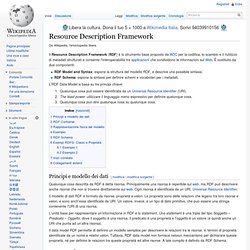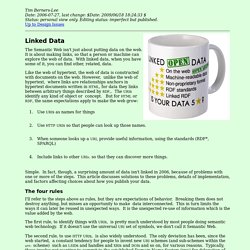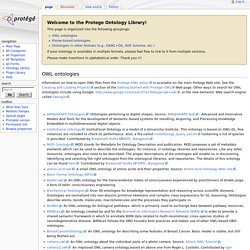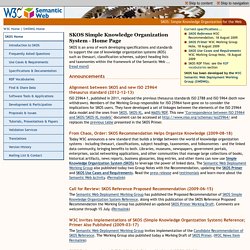

Resource Description Framework. Da Wikipedia, l'enciclopedia libera.

Il Resource Description Framework (RDF) è lo strumento base proposto da W3C per la codifica, lo scambio e il riutilizzo di metadati strutturati e consente l'interoperabilità tra applicazioni che condividono le informazioni sul Web. È costituito da due componenti: RDF Model and Syntax: espone la struttura del modello RDF, e descrive una possibile sintassi.RDF Schema: espone la sintassi per definire schemi e vocabolari per i metadati. L'RDF Data Model si basa su tre principi chiave: Qualunque cosa può essere identificata da un Universal Resource Identifier (URI).The least power: utilizzare il linguaggio meno espressivo per definire qualunque cosa.Qualunque cosa può dire qualunque cosa su qualunque cosa.
Principi e modello dei dati[modifica | modifica sorgente] Qualunque cosa descritta da RDF è detta risorsa. Linked Data - Design Issues. Up to Design Issues The Semantic Web isn't just about putting data on the web.

It is about making links, so that a person or machine can explore the web of data. With linked data, when you have some of it, you can find other, related, data. Like the web of hypertext, the web of data is constructed with documents on the web. However, unlike the web of hypertext, where links are relationships anchors in hypertext documents written in HTML, for data they links between arbitrary things described by RDF,. Use URIs as names for things Use HTTP URIs so that people can look up those names. Simple. The four rules I'll refer to the steps above as rules, but they are expectations of behavior. The first rule, to identify things with URIs, is pretty much understood by most people doing semantic web technology. CIDOC CRM. Shape Acquisition and Processing Ontology — AIMATSHAPE.NET.
Ontologies and Logic Reasoning as Tools in Humanities? Abstract In this article, we evaluate approaches using logic reasoning applied to an ontology for literary characters.

The inference tool Racer and the programming language Prolog were tested and compared to see if they can serve as a computer assisted approach in this scenario. Both offer options to draw inferences, but the usage requests a good comprehension of logics. Intuitive and individual queries are also difficult to produce with solely logic constructs. Furthermore, information in humanities is often vague, ambiguous, or even contradictory.
At the moment, to the author’s knowledge, only few such approaches, especially in literature studies, have been published. Information seems to be essential for our lives. But does the obvious popularity of ontologies really point at the advantages? There are some criticisms of ontologies [Veltman 2004], [Shirky 2005]. Such a method is also of interest for schemes and models of topics in the humanities. Introduction to Ontologies Figure 1. Open-ontology.org. Rchoetzlein. Knowledge organization is the problem of arranging and classifying what we collectively know as a society in ways that can be easily understood and communicated to others.

The issues addressed in this thesis include the representation and storage of knowledge, semiotics, ontology, classification, systems for knowledge organization, and the visualization and aesthetics of knowledge systems. The Quanta software system is presented as a generic framework for the integrated storage, organization and visualization of human knowledge in interdisciplinary contexts. Novel contributions are made to both technical and conceptual aspects of knowledge organization. Technical contributions include a hypergraph structure for the storage and efficient representation of knowledge, comparative zoomable timelines for the visualization of events in time, circle packing with dynamic loading to visualize trees, and a distributed architecture and protocol for social knowledge systems. Ontology Matching. Protege Ontology Library. OWL ontologies Information on how to open OWL files from the Protege-OWL editor is available on the main Protege Web site.

See the Creating and Loading Projects section of the Getting Started with Protege-OWL Web page. Other ways to search for OWL ontologies include using Google: or the new Semantic Web search engine called Swoogle. AIM@SHAPE Ontologies: Ontologies pertaining to digital shapes. SKOS Simple Knowledge Organization System - home page. SKOS is an area of work developing specifications and standards to support the use of knowledge organization systems (KOS) such as thesauri, classification schemes, subject heading lists and taxonomies within the framework of the Semantic Web ...

[read more] Alignment between SKOS and new ISO 25964 thesaurus standard (2012-12-13) ISO 25964-1, published in 2011, replaced the previous thesaurus standards ISO 2788 and ISO 5964 (both now withdrawn). Members of the Working Group responsible for ISO 25964 have gone on to consider the implications for SKOS users. CIDOC. The CIDOC CRM. OntologWiki: Ontology Summit 2012. Ontology Summit 2012: Ontology for Big Systems (2Y6C) This Summit is , and is the 7th in the series of 3-month open annual events, by and for the Ontology Community and their collaborators. (2Y6D) see: , our , and (2Y6E) see this year's - (3AL2) Ref. note that your endorsement will be made by you as an individual, and not as a representative of the organization(s) you are affiliated with (39WG) this solicitation will be open for one month (and was closed as of end-of-day 12-May-2012; then extended for a week) 2012_04_13 - the was formally adopted by the community at the (39WC)